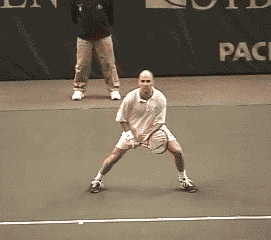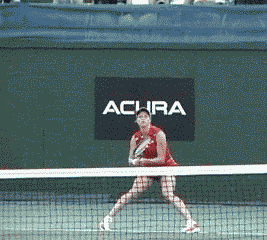|
TennisOne Lessons Practice Routines
Vary the Type of Practice to Maximize Improvement David Smith, Senior Editor TennisOne
When players think about practicing tennis, the common thought is to hit balls over and over to the same spot until the player can hit near the target with regularity. While this practice routine has purpose, it is only one of many practice patterns that a player can employ. At our academy, such practice is certainly one of our ‘stroke grooving’ patters used to develop player repetition and confidence. However, players should look at other practice procedures to ‘round out’ their playing abilities and improve their overall tennis skills.
Practice Plans Here are some ideas to consider when you head out to the practice court. Extreme Angle Volley Practice: It is interesting that the majority of players who learned to volley with an eastern grip (as they are more familiar and easier to simply hit a volley over the net), can’t hit extreme angles. Thus, players who are trying to learn to volley well should include the practice of hitting the ball at sharp angles when close to the net. The continental grip is best suited for this and it is a great way to become accustomed to using this grip.
Extreme Angle Groundstrokes: Similar to the volley, hitting severe crosscourt topspin forehands and backhands can teach you how to brush up the ball more significantly. Such shots are useful in working on passing shots that are dipping before they reach the net as well as learning to open the court up by pulling your opponent off the court with a significant angle. Inside-out volleys and groundstrokes: Many pros tend to feed balls to the forehand when players are on the deuce side. They also tend to work the backhands on the ad side. (These descriptions are for right-handed students.) While these strokes should be practiced regularly, players often neglect working on the inside ball, (forehand on the ad side, backhand on the deuce side). Working on short inside balls directed to the outside, crosscourt corner, is an imperative shot in doubles.
Typically, players who move forward to retrieve a short ball hit to this inside stroke will pull this shot down the line. This is due to the player usually rotating their hips around as they step through during the stroke. Players will want to learn the carioca step or learn to drag their back foot during the contact phase of the shot so-as to not pull this short inside ball down the line. (This is discussed in my article on the backhand volley, "The Backhand Volley--a visual comparison.")
Alternating targets: Hit the same forehand or backhand to alternating targets. Alternating Heights: Work on hitting high and low balls alternately to the same target. Alternating Spins: Work to hit a slice followed by a topspin groundstroke. Alternating Pace: Develop your ability to drive the ball and then hit a drop shot. Alternating Strokes: Hit an overhead followed by a volley; Or, hit an approach shot followed by a volley. In addition to working specific strokes and directional control, players will need to improve their ability to react correctly in quick exchanges. These are what I call ‘fast hands drills. Rapid fire drop shot drill: Have a partner hit hard, fast shots. Your job is to learn to take pace off the ball and direct the ball at significant angles with underspin Overhead Volley Drill: Have a player serve or hit overheads from near the baseline while you are at the net. Work on directing these ‘reaction’ volleys to different targets. Be careful to work up to higher speeds on the overheads because if the player at the net is not used to this drill he could get hit with one of these shots!
Back and forth drop shots: Have a player hit soft balls to your left and right—far enough that you must take several steps to get each shot. You must hit drop volleys or angle volleys on each of these soft balls. (Many players can’t adjust to soft balls and don’t know how to return them with an effectively placed shot.) Footwork practice Often players only hit (practice) balls they are moving towards. Yet often we encounter situations where we will be backing out and have to return to a position. To practice this, you can have a player hit three balls across the baseline with you ‘backing out’ and hitting the ball moving first away from the ball then immediately moving back into the shot. This improves footwork and balance. Other drills I like to use with more advanced players are “One-foot drills,” where the player must hop on one foot and learn to balance on this foot while hitting the ball. Tough at first, however, most players discover they hit more consistent shots in this drill. The reason is simple: being on one foot forces the player to swing only as hard as they can while still remaining balanced, (without fall down!)
For forehands we will feed three balls across the baseline or along the net (for volley practice on one foot). Players must hop and get in position and then swing and hold their finish on this one foot. (We usually have them hop on their left foot for right-handed forehand and right foot for the one and two-handed backhands.) We will also practice serving standing on one foot (Left foot for right-handed players). This teaches players to serve with more balance. It also teaches them to push off and land on the front foot, instead of walking through the serve with the back foot. Walking through the serve makes the player open up too early and forces them to flatten the serve out. I hope you will find these drills helpful and thought-provoking. Many players need to be creative in their practice routines. Those that do will find themselves more comfortable and able to react better in pressure situations. Also, all of these drills will help players reach a level of ‘unconscious competency’ when practiced with good technique. Best of luck to you all! Your comments are welcome. Let us know what you think about this article by emailing us here at TennisONE. TENNIS MASTERYLearn more from Dave Smith from his best-selling book, TENNIS MASTERY or, learn from Dave personally at his academy, The St. George Tennis Academy. Learn the “Advanced Foundation” within the spectacular setting of Southern Utah, close to Zion National Park, the Grand Canyon and Bryce National Park. Dave's new club, The Summit, is a $7 million dollar tennis, swim and fitness center. For more information, call (435) 628-5000 and ask for the Summit Tennis Pro Shop. Dave specializes in drop-in programs and private tennis sessions by appointment. He has not only taught several top twenty world-ranked juniors and pros, but also teaches a number of top nationally ranked senior players. For senior players, Dave will be hosting a 'senior tennis camp' for two days before the Huntsman World Senior Games in St. George Utah. (One of the premier Senior Games events in the world! See www.seniorgames.net for more info!) Finally. a resource that unlocks these mysteries: • Why do m • Why are making changes in one's game so frustratingly difficult? • What tennis teaching methods are disruptive or detrimental to player progression? Read David W. Smith's TENNIS MASTERY and learn not just how to avoid playing at mediocre levels, but how the best players in the world Master the sport of tennis! "With a depth of knowledge and fresh perspective, TENNIS MASTERY is set to become a manual for tennis instructors and a measure for tennis literature." Richard Wigley, Director, Kayenta Tennis Center , Ivins Utah . Take in David Smith's 30 plus years in the tennis teaching industry. This 335-page manual will provide for every level of player as well as support for all tennis-teaching professionals, a blueprint for reaching higher levels of tennis mastery. Order TENNIS MASTERY at tenniswarehouse.com , or go to tennismastery.net for exciting excerpts from the book and a host of tennis information! And check out David Smith's other articles found here at TennisONE.com |

 Andre Agassi is a master at the sharp angled groundstroke.
Andre Agassi is a master at the sharp angled groundstroke. 
 illions of tennis players stagnate at levels far below their potential?
illions of tennis players stagnate at levels far below their potential?